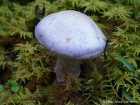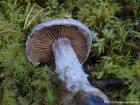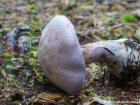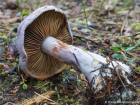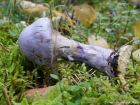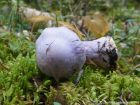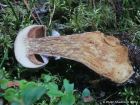Cap initially spherical to convex, with the margin rolled inward, later flattened, sometimes with a large, broad, central umbo. The margin often cracks star-like, particularly in dry weather. Colour first pale azure violet to pale lilac colour, later fading to tan-brown or rusty brown. The surface is dry, silkily shiny or tomentose at the margin with membranaceous bronze fragments of the veil, it becomes later cracked into small scales. Gills sub-crowded, quite thick, broadly adnate, and often slightly emarginate. Colour slightly dirty violet when young, later brown. Stem tough and thick, bulbously at the base, and spongily stuffed inside. It is vivid violet for a long time in the upper part above the cortina, paler below, and covered with a tough, whitish, boot-like veil, which usually leaves upright zones on the stem. The cortina is violet. The flesh is saffron yellowish-brown to yellowish-brown except at the tip of the stem where it is dirty violaceous. Spore print rusty brown.
Microscopic Features:The spores are ellipsoid in shape, adorned with fine warts or dots, and have measurements of approximately 8-9 μm in length and 5-5.5 μm in width.
Cortinarius traganus on Wikipedia.
Many mushrooms are poisonous, and some can be lethally toxic. Distinguishing between edible and poisonous mushrooms can be very challenging. Therefore, we strongly advise against consuming wild mushrooms. This website does not contain any information about the edibility or toxicity of mushrooms.
Although efforts have been made to ensure accuracy on this website, the information may contain errors and omissions. Therefore, all content provided is for educational and informational purposes only and should not be relied upon or used as a basis for consuming any plants or mushrooms.
External links are provided for reference only. We do not endorse or take responsibility for the content, advice, or products found on these sites or in any advertisements shown on this website.
